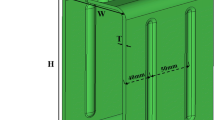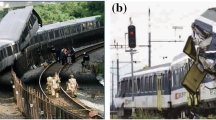Abstract
The design of an engine room is important to protect the passenger from a crash impact by improving the absorption of the crash impact energy. The side member in the engine room absorbs most of the crash impact energy when the vehicle experiences a frontal crash. The side member is of two types: hat and ‘U.’ Analysis of the extent of energy absorption and the mechanism of the side member are necessary through a collapse mode in various load conditions. In this study, the design of experiments was used for evaluating the characteristics of the absorption of crash energy by side members through design variables. First, crash analysis was performed by experiment number extracted from the design of the experiment. Then, using the results of crash analysis, multiple regressions were conducted and sensitivity analysis performed for each design variable. Finally, the optimum design was developed for maximizing the absorption energy per unit weight considering various boundary conditions. In the present study, as a basic step for modeling the fatigue behavior of an extruded Al alloy cylinder, the fatigue crack growth data of the alloy was collected in two orientations. Microstructural analysis revealed that the material had recrystallized grains and clusters of constituent particles aligned in the direction of extrusion. Fatigue life of the samples revealed a shorter fatigue life representing a higher fatigue crack growth rate in the transverse direction.
Similar content being viewed by others
References
L. Lorenzo, M. Mirdamadi and K. Fennessy-Ketola, A Methodology for developing interior trim panels to comply with the new FMVSS201 legislation, International Congress and Exposition, SAE paper 960152 (1996) 1–9.
H. Y. Kim, J. K. Kim, S. J. Heo and H. Kang, Design of the impact energy absorbing members and evaluation of the crashworthiness for aluminum intensive vehicle, International Journal of Automotive Technology, 10(1) (2002) 216–233.
J. S. Koo and Y. H. Youn, Crashworthy design and evaluation on the front-end structure of Korean high speed train, International Journal of Automotive Technology, 5(3) (2004) 173–180.
J. S. Koo, H. J. Cho and T. S. Kwon, A study on establishing the accident scenarios for crashworthiness of rolling stocks, Korean Society for Railway spring conference (2007) 1–10.
E. K. Kim, Study on the design of the passenger cars bumper rail to reduce the weight, Chonnam National University, Thesis for a master degree (2001).
K. H. Yoon, Plastics in automotive components, Advanced Materials and manufacturing in Automotive Engineering, 28(1) (2006) 33–39.
T. Matsuoka, J. Takabatake, A. Koiwai, Y. Inoue, S. Yamamoto and H. Takahashi, Integrated simulation to predict warpage of injection molded parts, Polymer Engineering and Science, 31(14) (1990) 1043–1050.
H. J. Kim, H. Cho, H. S. Jung, T. S. Kwon and M. W. Suh, Crashworthiness design and evaluation on the leading-cap structure of rolling stock using topology, International Journal of Precision Engineering and Manufacturing, 10(2) (2009) 79–85.
H. J. Kim, S. H. Kim, H. S. Jung, T. S. Kwon and M. W. Suh, The study on conceptual structure design in protective shell frame of rolling stock leading-cab using topology optimization, KSAE spring conference, 4 (2007) 2025–2030.
M. P. Bendsoe and N. Kikuchi, Generating optimal topologies in structural design using a homogenization method, Computer Methods in Applied Mechanics and Engineering, 71(2) (1998) 197–224.
Author information
Authors and Affiliations
Corresponding author
Additional information
Recommended by Associate Editor Chang-Wan Kim
Yung-Won Suh received his B.S. degree in Mechanical Engineering from Seoul National University, Republic of Korea, in 1981. He then received his M.S. degree from the Korea Advanced Institute of Science and Technology in 1983 and his Ph.D. from the University of Michigan in 1989. Dr. Suh is currently a professor at the School of Mechanical Engineering in Sungkyunkwan University in Suwon, Korea. He serves as a committee member of the Korean Society of Automotive Engineers and Society of Automotive Engineers. He was the editor of the International Journal of Automotive Technology (IJAT) until 2007. Dr. Suh’s research interests include structural analysis, optimization, human factors, and evaluation of reliability.
Bae-Young Kim received his B.S. degree in Mechanical Engineering from Sungkyunkwan University, Republic of Korea, in 2006. He then received his M.S. degree from Sungkyunkwan University in 2008. Kim is currently a doctoral student at Sungkyunkwan University. Kim’s research interests include structural analysis, optimization, and human factors.
Rights and permissions
About this article
Cite this article
Kim, BY., Jeong, CM., Kim, SW. et al. A study to maximize the crash energy absorption efficiency within the limits of crash space. J Mech Sci Technol 26, 1073–1078 (2012). https://doi.org/10.1007/s12206-012-0232-y
Received:
Revised:
Accepted:
Published:
Issue Date:
DOI: https://doi.org/10.1007/s12206-012-0232-y




